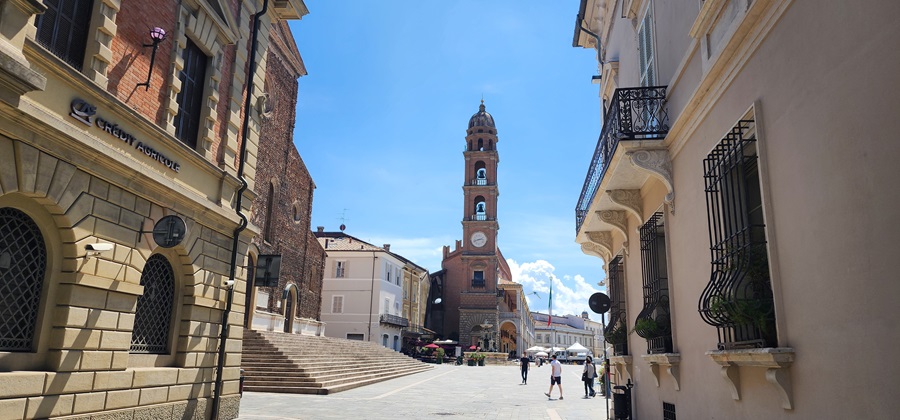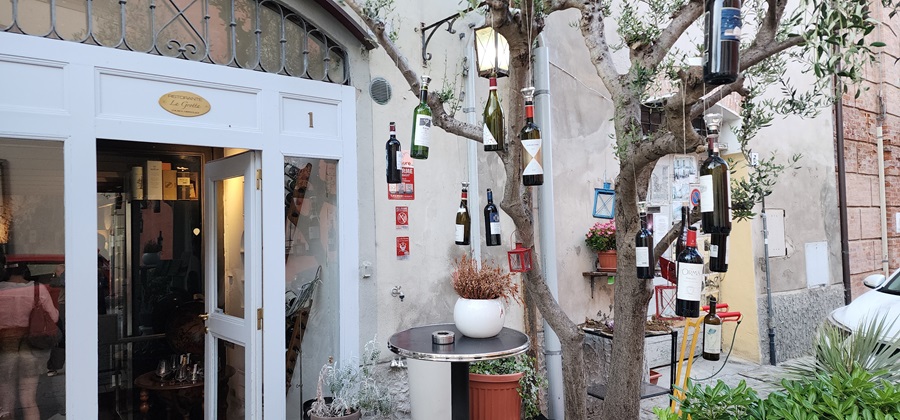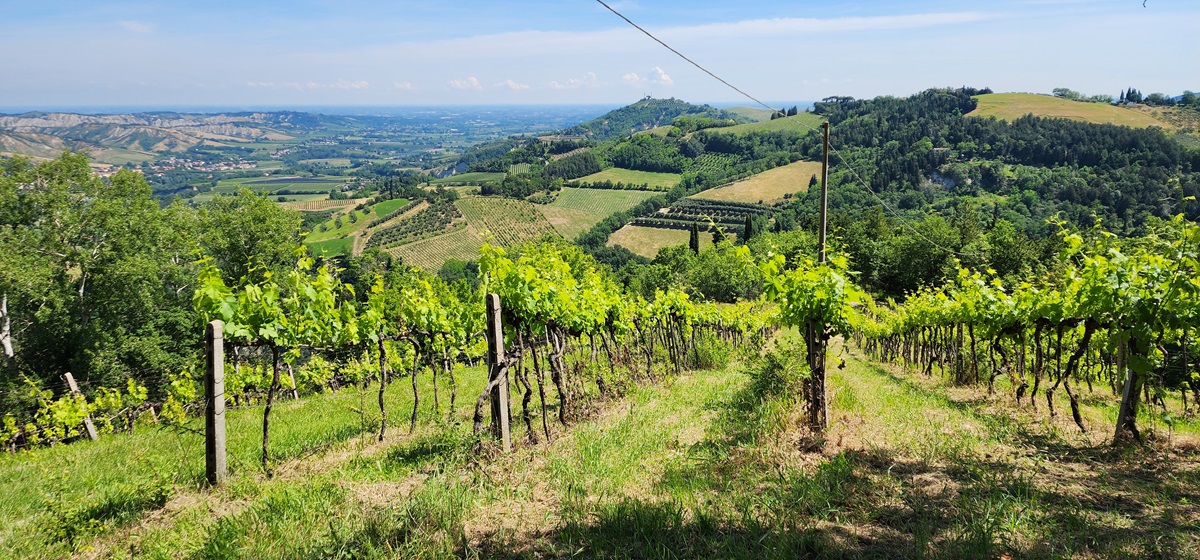If you are a traveler who likes to head off the beaten path, then Emilia-Romagna in northern Italy is the place to be. A far less touristy region than its neighbors Lombardy and Veneto to the north and the Marche and Tuscany to the south, Emilia-Romagna offers elegant medieval cities, sun-soaked Adriatic beaches, and some of the best cuisine in Italy. Known as the gastronomic capital of Italy, it is home to the world’s finest balsamic vinegar from Modena, prosciutto and Parmigiano-Reggiano cheese from Parma, and pasta and meat sauces from Bologna. And to wash down all the delicious cuisine, Emilia-Romagna also produces wine.
Before Italy became a country, Emilia and Romagna were separate with distinct histories. Emilia was mainly formed by a series of independent duchies, while Romagna was under the Papal State. Emilia is more industrial and landlocked, with a Roman and medieval history centered around food and manufacturing. Romagna, originating from the Latin name Romania, meaning “land inhabited by Romans,” is the eastern part of the region extending to the Adriatic coast. Romagna has a strong Byzantine influence, especially in Ravenna, which was once the capital of the Western Roman Empire. Romagna’s economy thrives on tourism, particularly in coastal cities like Rimini. While the two regions are united today, Romagna retains its own distinct cultural identity, even a separate dialect, and produces different wines.
The first wine that might come to mind is Lambrusco, the most famous wine from Emilia-Romagna. If you are in Bologna, the capital of Emilia-Romagna, or in Piacenza, Parma, Reggio Emilia, or Modena—all provinces northwest of Bologna on the Emilia side—Lambrusco is the wine you will often find on wine lists. But if you head southeast of Bologna to the Romagna portion of Emilia-Romagna, you will find Sangiovese and Albana, a white grape.
Wine in Romagna

Wine has been made in Romagna, near Faenza, for centuries. Many producers are located on the plains, but 50 years ago, the region began to develop in the hills and mountains. One of the first to plant vines in the hills was Ronchi di Castelluccio. Located in Modigliana, the property was once part of the Apennine Woods, and the “roncola” was an ancient tool used to chop down trees. The estate was founded in 1974 by filmmaker Gian Vittorio Baldi. With enologist Vittorio Fiore and agronomist Remigio Bordini, Ronchi di Castelluccio produced the first Cru wines in Romagna. Today, Remigio Bordini’s son, Francesco Bordini, is the agronomist.
In 2020, the property was purchased by brothers Aldo and Paolo Rametta. The brothers were born in New Orleans and raised in the United States and Switzerland. They had successful careers in renewable energy and finance but decided to return to Italy, reconnecting with their family roots in Romagna. With a passion for Romagna wines, especially Sangiovese di Romagna, they aimed to create a fresher version of Sangiovese.
According to the Rametta brothers, Sangiovese is the best interpreter of the land. Sangiovese di Romagna DOC can be produced within sixteen subzones in Romagna, each offering a different expression. Within Romagna DOC, there are subzones such as Brisighella, Modigliana, and Castrocaro, where the vineyards of the Rametta brothers are located.
Another important grape is Albana, a versatile white grape that became Italy’s first white DOCG in 1987, covering twenty municipalities. While there were once 10,000 hectares planted, today only 1,000 hectares of this grape remain.
The Rametta brothers first purchased Poggio Della Dogana in 2016. Poggio Della Dogana consists of two estates in two municipalities, Brisighella and Castrocaro, planted with Sangiovese and Albana. With all hillside vines, Castrocaro offers clay soils, while Brisighella has calcareous soils. The vines are more than 20 years old and are farmed organically. At Ronchi di Castelluccio, they have replanted vineyards and preserved a plot of Sangiovese planted in 1974 called Ronco della Simia, or “vineyard of the monkey.”
Both Ronchi di Castelluccio and Poggio Della Dogana are certified organic. Olive trees are planted on the estates to support climatic and organic cultivation. Bees between the vineyard rows add to the biodiversity. They also maintain 120 cattle and 15 sheep, using their manure to create a sustainable ecosystem. At Ronchi di Castelluccio in Modigliana, there are five hectares of woods for every hectare of vineyard.
With vineyards planted on mountains between the Apennines and the Adriatic Sea, the Rametta brothers are producing wines with freshness. Inspired by French wine styles, and unique for Romagna, they produce several cru, or single-vineyard wines, such as Buco del Prete, Arlesian, Quattro Bastioni, Ronco dei Ciliegi, and Ronco della Simia, showcasing fresh notes of dark cherry, minerality, and elegance.
Romagna Day Trip Tips

To explore the Sangiovese and Albana wines of Romagna, consider taking a day trip from Bologna. Faenza, a major city in the province of Ravenna, is just an hour from Bologna. Faenza is named after the French word faience, a type of ceramic pottery that has been made there since the 12th century. Also known as Maiolica, this technique involves painting with ceramic pigments on a white glaze background over terra-cotta. In Faenza, visit the Ceramics Museum and explore the approximately 60 ceramic workshops offering beautiful pottery. Stroll through Faenza’s historic medieval town, starting in the long open square with its unique tower featuring two bells and a clock.
RECOMMENDED: Book One Of These Highly-Rated Private & Guided Wine and Food Tours From Bologna
Many wineries surround Faenza. Ronchi di Castelluccio in Modigliana is a 25-minute drive southwest of Faenza. Guests are welcome to visit the historic property by contacting Ronchi di Castelluccio via email. Poggio Della Dogana in Castrocaro Terme is a 25-minute drive southeast of Faenza. Explore the different single-vineyard Sangiovese di Romagna DOC wines and add a food pairing for a full gastronomic experience. Reservations can be made via their website.

Before heading back to Bologna, stop for dinner in Brisighella at Ristorante La Grotta (The Cave Restaurant). The dining room is located inside ancient caves dug into the Romagna chalk beneath the historic Via degli Asini. The restaurant is owned by Mirko Conti and Angelo Randi, two friends who worked together at national and international starred restaurants. They revived this historic Michelin-starred restaurant in Brisighella. Using seasonal and local ingredients, the menu offers traditional Romagna dishes, such as passatelli with squid and local pork cheek braised in Sangiovese, as well as modern dishes like scallop tataki and beetroot risotto.
If you wish to spend more time exploring Romagna, consider staying overnight at the Hotel Vittoria in the heart of Faenza’s historic center. A historic noble residence, the hotel offers 49 spacious and recently renovated rooms, ranging in style from classic décor to more modern designs. The hotel is a short walk from the central Piazza del Popolo, the Ceramics Museum, and other attractions.
